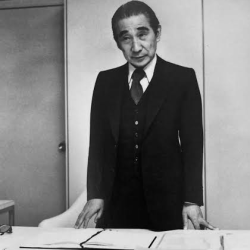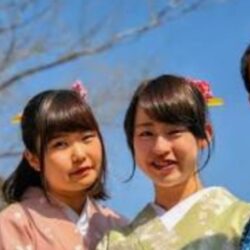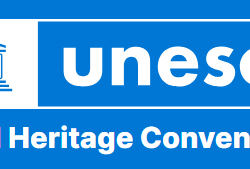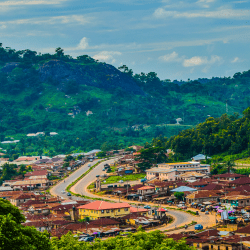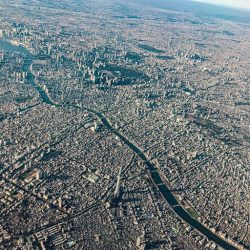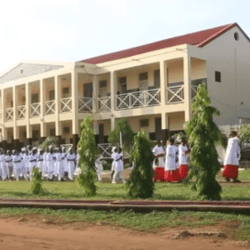Kenzo Tange was born on September 4, 1913, in Osaka, Japan. He spent his early years moving between different cities due to his father’s job as a civil engineer, which exposed him to various aspects of the built environment. His interest in architecture began after seeing Swiss-French architect Le Corbusier’s plans for the Soviet Union’s Palace of the Soviets. This sparked his desire to pursue architecture as a career.
Tange studied architecture at the University of Tokyo under the guidance of prominent Japanese architect Hideto Kishida. He graduated in 1938 and later became a professor at the university, where he would mentor many future architects. His education during this time was influenced by a mixture of traditional Japanese building techniques and modern Western architectural theories, which shaped his unique design approach.
What is Kenzo Tange best known for? Kenzo Tange is best known for his fusion of traditional Japanese design with modernist architecture and his iconic projects such as the Hiroshima Peace Memorial, Yoyogi National Gymnasium, and his urban planning concepts like the Tokyo Bay Plan.
How did Kenzo Tange influence modern architecture? Tange’s work introduced a blend of modernist principles with cultural sensitivity, influencing architects worldwide by showing how traditional elements can coexist with modern forms.
What was the Metabolism Movement? The Metabolism Movement, which Tange helped lead, was an architectural movement that advocated for buildings and cities to be dynamic and adaptable, capable of growth and change over time.
What awards did Kenzo Tange receive? Tange received numerous prestigious awards, including the Pritzker Architecture Prize in 1987 and Japan’s Order of Culture.
What is Kenzo Tange Associates? Kenzo Tange Associates is the architectural firm founded by Tange, which continues to operate and contribute to global architecture today.
What is Tange’s most famous project? One of Tange’s most famous projects is the Yoyogi National Gymnasium, which became a symbol of Japan’s modernization for the 1964 Tokyo Olympics.

List of Kenzo Tange’s major projects
Tange started his major work in 1949 with the Master Plan for Hiroshima, a city in Japan
In 1958 he worked on Imabari City Hall Complex. 1958: Kagawa Prefectural Government Office. 1957: Former Tokyo Metropolitan Government Office. 1955: Tosho Printing Company Haramachi Factory. 1952: Main Building of Hiroshima Peace Memorial (Former Hiroshima Peace Center ).
1966: Yamanashi Press and Broadcasting Center. 1965: Master Plan for Reconstruction of Skopje City Center. 1964: Saint Mary’s Cathedral, Tokyo. 1964: Yoyogi National Gymnasium. 1964: Redevelopment Plan of Tsukiji District Proposal. 1960: Headquarters Building for WHO in Geneva. 1960: A Plan for Tokyo. 1960: Kurashiki City Art Museum (Formerly Kurashiki City Hall).
In 1979 Kenzō Tange worked on Central area of New Federal Capital City of Nigeria.
1977: Sogetsu Hall and Office. 1971: University of Oran Including Hospital and Dormitory. 1971: Fiera District Center Master Plan. 1970: Kuwait Embassy and Chancellery. 1970: Master Plan for Expo ’70.
1986: One Raffles Place Tower 1 (Former OUB Centre). 1982: Royal State Palace. 1982: King Faisal Foundation Headquarters Complex Phase1. 1982: Akasaka Prince Hotel. 1980: Napoli Administration Center.
1998: BMW Italia Headquarters Building. 1998: Nice Asian Art Museum. 1996: Fuji Television Headquarters Building. 1995: UOB (United Overseas Bank) Plaza. 1994: Shinjuku Park Tower (Park Hyatt Tokyo). 1992: Grand Ecran. 1991: Tokyo Metropolitan Government Office.
2009: Konig Foods Headquarters and Factory, Tao Yuan, Taiwan. 2008: MODE GAKUEN Cocoon Tower. 2008: Romeo Hotel. 2006: The Cathay. 2005: The Cancer Institute Hospital of JFCR. 2005: The Prince Park Tower, Tokyo. 2005: President International Tower. 2005: Shanghai Bank Headquarters Building. 2004: West Kowloon Arts and Cultural District.
2018: University of Bahrain Masterplan. 2018: University of Bahrain College of Engineering. 2018: Fubei New World. 2017: Nagoya Toyopet Dankeidori. 2016: Bank Danamon New Headquarters Building. 2015: Isetan Shinjuku Main Store Renewal Project 5th & 6th floors(Interior), ASIJ Creative Arts Design Center. 2014: Discovery Primea, Hung Sheng International Finance Center, Orchard Gateway. 2013: Oak Omotesando. 2012: One Raffles Place Tower. 22011: Henderson Metropolitan

